C. Lee Huff, division president
 Big. Large. Gigantic. Massive. Mammoth. Enormous. Titanic. It is not possible for one word to adequately describe the territory of the Euro-Asia Division (ESD). Twelve countries. Eleven time zones. Eight and a half million square miles. One country alone in ESD, Russia, is 70 percent larger than Canada and nearly twice the size of China or the United States. Lake Baikal in Russia is the size of the country of Belgium.
Big. Large. Gigantic. Massive. Mammoth. Enormous. Titanic. It is not possible for one word to adequately describe the territory of the Euro-Asia Division (ESD). Twelve countries. Eleven time zones. Eight and a half million square miles. One country alone in ESD, Russia, is 70 percent larger than Canada and nearly twice the size of China or the United States. Lake Baikal in Russia is the size of the country of Belgium.
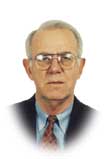
There are more than 285 million people in the ESD who must hear the gospel story before Jesus can return. Although the Seventh-day Adventist Church has grown tremendously since the fall of Communism, only a very small percentage of the population are Adventists, about 135,000.
The largest number of Adventists in the division is in the Ukraine and Russia. Adventism first began in ESD in 1886 with the baptism of 19 people in the Crimea. Although many members were persecuted and imprisoned during the Communist era, by the time the Euro-Asia Division was formed in 1990, the church had grown to 30,000. By 1995 the membership was about 99,000.
Tremendous Contrast, Different Methodology
Naturally there are tremendous contrasts in a territory of this size. There are 4,800 miles of arctic coastline in Russia, while in Central Asia, the highway follows the old Silk Road, which merchants traveled on camelback. Camels are still an important part of society in Central Asia, while at the same time the Siberian tiger is facing extinction in the far east of Russia.
Volcanoes. Glaciers. Deserts. Taiga. Siberian remoteness and Moscow congestion. Wheat, silk, cotton. Grapes, melons, sunflower seeds. Coal, oil, iron ore, gold, diamonds.
Just as different methods are needed for growing and harvesting various crops, and different methods are needed for extracting various natural resources, a variety of methods are needed to reach the people of the ESD for Jesus Christ.
Culturally Sensitive Worship
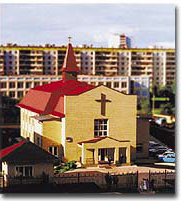
OUR FIRST HOME: This is the first church building that Adventists have ever own in Moscow, Russia. |
In the past year an Adventist "mosque" was opened and dedicated in Bishkek, Kyrgyzstan. Sabbath services will be held in this building, which is called a spiritual and cultural center. The people will worship God in the culture and traditions of Islamic people. Sabbath school and worship services will be conducted in both the Russian and Kyrgyz languages. The men will wear the traditional Kyrgyz skullcap, and the women will cover their heads. National music will be used. On both Friday and Sabbath evenings a prayer service, similar to the Muslim evening prayer service called namaz, will be conducted. At that time the worshipers will sit and pray on the carpeted floor.
The Central Asia Conference president says that as secularism increased, Kyrgyz people departed from Islamic principles. He asserts that today the people of Central Asia are returning to their cultural roots and are reviving their interest in religion. He hopes this culturally sensitive approach to worship will attract many of those seekers.
Through the years the growth of the Adventist Church in the republics of the U.S.S.R. came primarily from the Russian populace in those places. Very few nationals, especially Muslim nationals, were reached. Even though the Russian language, in many respects, was a uniting factor throughout the nation, the church seldom met the language and cultural needs of the various people groups. Most of the world recognizes the names of Lenin and Stalin as Soviet leaders, but only history buffs can trace the events of Tamerlane, who reigned and conquered vast areas of the present ESD from 1360 to 1405. Samarkand in Uzbekistan was Tamerlane's headquarters. The area is replete with Muslim history and is called the cradle of Islam. The dry desert climate helped preserve many centuries-old mosques and fortresses. Today many of these edifices stand proudly restored with the blue of their tiled mosaics matching the cloudless blue Uzbekistan sky.
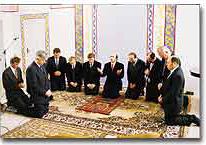
A CONSECRATED EVENT: Dedication of the mosque-like church in Bishkek,
Kyrgystan. |
Eight of the ESD's 12 countries lie in the 10/40 window. Many of these Muslim people are cultural Muslims only. Remember also that their religion was taken away from them during Communist times. Many Muslim people are searching for God and for peace that only a relationship with God can bring. They remember their grandparents telling them Old Testament stories; they remember seeing their grandparents praying and worshiping God. Many are attracted to the Adventist health message, which is so similar to their own beliefs.
Reaching the Oppressed
Fierce opposition to the Adventist Church often comes in various Orthodox communities; however, the most unbelievable and cruel opposition came last year in Ashgabat, Turkmenistan. A bulldozer, pickaxes, and a wrecking ball destroyed a new Adventist church, the only Adventist church in the country. Nothing but a pile of rubble remained. City officials said that the building had to be destroyed to make way for a new road; however, it has been stated publicly that no religions except Islam and Orthodox will be allowed in the country. New methods of evangelism must be developed for these oppressed areas.
Adventist World Radio (AWR) is a vital component of the overall evangelistic plans of the ESD. It may be the only means of reaching some people in the Muslim territories. Besides the expected broadcasts in the Russian and Ukrainian languages, programs are now being produced in the Kazak, Kyrgyz, Uzbek, Armenian, and Georgian languages. In addition to the good work of AWR, programs continue to be prepared for radio and television at the Voice of Hope media center in Tula. Baptisms from the Bible correspondence courses offered by their programs are ongoing.
The publishing work has historically been a strong evangelistic tool in the Adventist Church. For many years the production of Adventist literature in Russian and Ukrainian was done secretly underground. Now the Source of Life Publishing House (SOLPH) in Zaoksky, Russia, boldly churns out more than 18,000 pages a month. In the past five years more than 12 million pieces of literature have been produced.
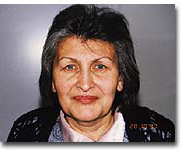
A LEADER FOR CHRIST: Olga Pivovarova is a successful evangelist in the ESD. |
Russian is the major language for publication, but Adventist literature has also been printed in Armenian, English, Georgian, Latvian, Tatar, Ukrainian, and Uzbek. The new two-color web press at SOLPH will easily increase production 10 to 20 times this amount.
In 1991 evangelists from Australia, the U.S., Germany, Canada, and other places eagerly began coming to the ESD to preach the gospel and to harvest the fruit of their labors. The hearts of people who lived for years in spiritual darkness were like blank pages on which were drawn the lovely face of Jesus. New churches sprang up as new freedoms were experienced. Although opposition was faced in some places, in many cities the visiting foreign evangelist was treated as a celebrity and as a messenger from heaven.
Getting Organized
Next came a period of constructing and acquiring buildings in which the new congregations could worship. (Unfortunately there are still more congregations across the division that worship in rented halls than in their own church buildings.) Expanding the organizational structure of the church was another needed step, thus conferences and unions were organized.
Today most of the division's departmental directors are well-qualified nationals who are devoted to the task of training union and conference leaders in the various ministries of the Seventh-day Adventist Church. The ESD is an infant division, but it is taking adult-sized steps in training and evangelism. Some of that evangelism is in the form of health evangelism. The Adventist Health Center in Moscow, for example, is expanding as a dental clinic. Stop-smoking programs and other health programs are regularly a part of community outreach across the ESD.
Higher Learning
Although it is very difficult to establish elementary church schools in the ESD, Zaoksky Theological Seminary (ZTS) is growing both in the number of students and in the programs that it offers. The 1999-2000 school year saw the biggest enrollment the school has ever experienced. There were 337 students on campus with several hundred in the extension programs that are taught at various sites throughout the division.
ZTS has always been a miracle school. Construction on the ZTS buildings began before the fall of Commun-ism. And that was just the beginning of the miracles. The students and staff experience miracles every single day. In addition to the original theology, music, and agriculture courses, programs are now offered in business, secretarial, and religion/English. Graduates from these courses are already strengthening the work of the church and the community.
With the present economic conditions in the ESD, it is impossible for a student to pay his or her own expenses at ZTS. Sponsors from around the world are lifting this load. In many respects, the future of the church in the ESD depends on the training of its young people. ESD and ZTS are forever grateful for the generosity of members of the world church who have had the foresight to train pastors and other leaders to work in ESD.
Wide-open Spaces
Although some areas seem to be closed to Adventist expansion, other areas are wide open. As new freedoms came to the former U.S.S.R., materialism and other ideologies replaced atheism. Immediately following the fall of Communism in 1991 many hearts and minds were completely open to new ideas. In many cases the religious group that first appealed to these people was the one that harvested them. Often-but not often enough-Adventism was the first
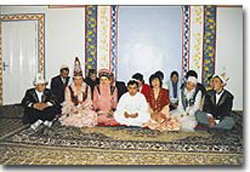
A CULTURAL EXPERIENCE: Worshipers in native costume at the dedication of the Bishkek, Kyrgystan, church. |
new way of life the people met. All the evangelistic campaigns that were conducted during those early years represented just a drop in the bucket of what could have been done when it was so much easier to get results. However, we do praise God for all the evangelism that has been done in the ESD, by both foreigners and nationals, since the division was formed in 1990. Many of the pastors throughout the division were baptized during the past four to seven years. Scores of successful campaigns are held each year by local pastors and by local church administrators. And there are several women evangelists in the ESD who reach people that men could not. It's especially important to have female workers in the Muslim countries.
Vast Potential
As we look ahead into this new millennium, it seems that there should be three points of focus. Number one, evangelism and soul winning should continue to be the main purpose of every church activity and every institution. Number two, training leaders of this growing church is an ongoing priority. Number three, procuring church buildings for the ever-increasing membership is a basic and very real need.
Siberia is wide open to the gospel at this time. The Adventist work began in many Siberian cities by those who had been exiled there. In the new earth many believers who gave their lives in remote Siberia will smile when they learn that their blood acted as seeds for the gospel. There is a frontier-minded, pioneering, open spirit in Siberia.
The potential for the Adventist Church in Siberia, and in all of the ESD, is as vast and indescribable as is the territory itself. Yes, the diversity of geography and culture is a challenge, but it's also a very exciting and imaginative aspect, because it's impossible to be locked into one method! More precious than the diamonds of Siberia and the ancient treasures of Central Asia are the multitudes of people who will respond to the call of Jesus-once they hear it. As they enter this new millennium, the administrators, pastors, and laypeople in the ESD are committed to making sure, with God's help, that the 285 million people in their territory will have the opportunity to hear the call of Jesus. They want others to know the joy that they know. They want to go home!


 FREE NEWSLETTER
FREE NEWSLETTER